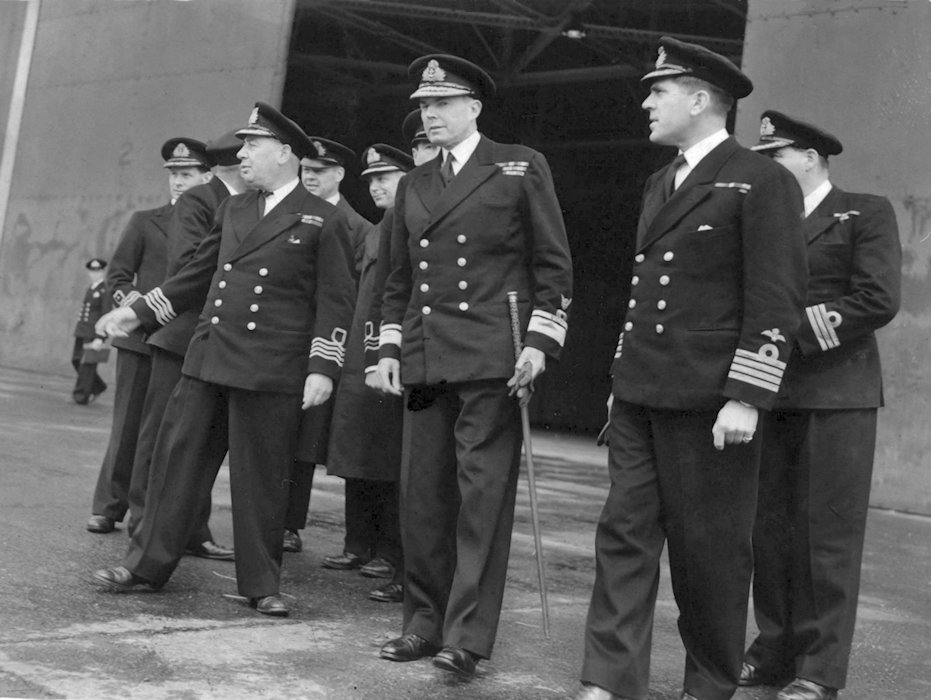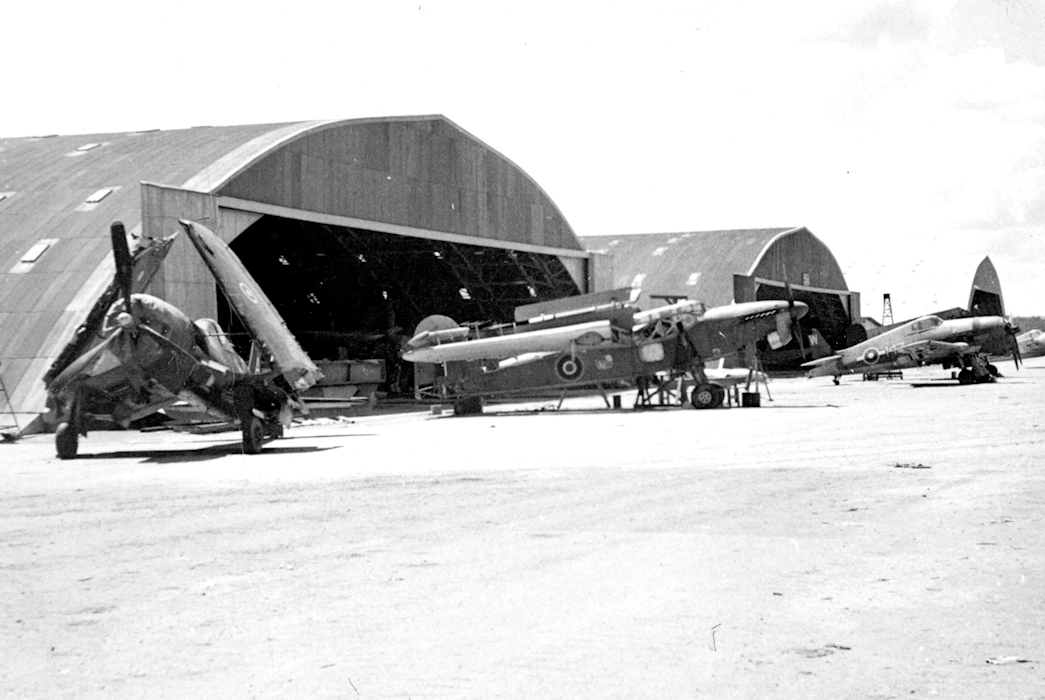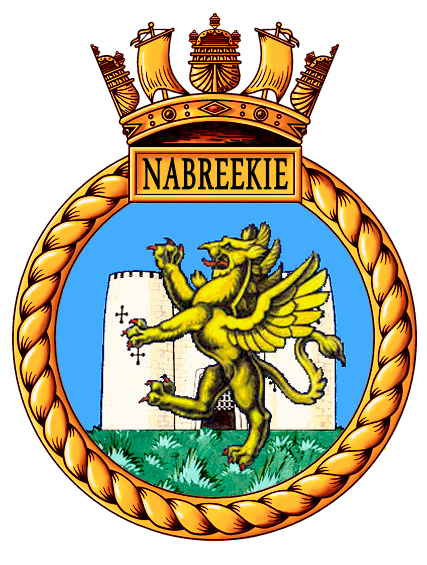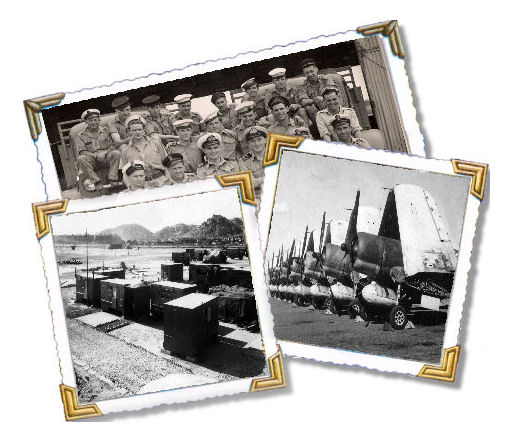Mobile Naval Air Base No. VII
Assembly and commissioning in the UK
Personnel and equipment for Mobile Naval Air Base VII began to assemble on March 19th 1945 at RNAS Middle Wallop, Hampshire, the new headquarters of the Mobile Naval Airfields Organisation (MNAO). It was to assemble as a second Receipt and Despatch unit (RDU). MONAB VII differed from its predecessor MONAB II in the fact that no Maintenance, Storage & Reserve (MSR) components were included in the units' make up, instead the unit would have two Maintenance Servicing and one Mobile Maintenance components, as would a standard MONAB, with the addition of Erection, Equipping and Stripping units as the Receipt & Despatch components.
MONAB VII was allocated the following maintenance components:
Mobile Maintenance unit (MM) No. 6 supporting Avenger Mk. I & II, Corsair Mk. II & IV, Hellcat Mk. I & II and Seafire Mk. III & L.III
Maintenance Servicing unit (MS) No. 11 supporting Firefly Mk. I
Maintenance Servicing unit (MS) No. 12 supporting Sea Otter Mk. I
Erection & Equipping Units supporting Avenger Mk. I & II, Corsair Mk. II & IV, Hellcat Mk. I & II, Seafire Mk. III & L.II, Sea Otter Mk. I & Vengeance TT.IV
Stripping Unit as above but excluding Vengeance.
As a larger unit MONAB VII had a nine-week forming up period as the new components had not been assembled before; the Receipt and Despatch tasks were already carried out by both MONAB II and TAMY I, but as part of their design, however these components which required their own compliment and scale of equipment and stores had never been planned for as separate components. Technical ratings were drafted from R.N. Barracks, Lee-on-Solent, and general service ratings from R.N. Barracks, Chatham.
Like the previous units much time was spent in giving drafting leave to Officers and ratings who were supposed to have had it before they joined, also a large proportion of personnel that were being drafted to join the unit were found to be untrained for their assigned billets, especially drivers, or were too old or unfit for service overseas so replacements had to be requested.
Major problems arose concerning motor transport; all vehicles allocated to MONAB VII were held by the H.Q. unit and were not released until it was put on the road for movement to the Port of Shipment. This measure prevented the MONAB VII M.T. Maintenance Officer from taking the proper precautions to preserve the vehicles for passage and articles like tool kits and toolboxes were missing on arrival of the vehicles in Australia, because no proper arrangements had been made to secure them. Although an M.T. Maintenance Party travelled in the store ship, it was not possible to work on any vehicles other than those on the upper deck. The training of drivers was also problematic; there was no provision for M.T. driving instruction by the MNAO HQ so it was lest to MONAB VII to organise Its own M.T. course lasting 14 days for both officers and ratings (including Royal Marines).
With the formation of MONAB VII a new system was introduced for the handling of unit stores; instead of all stores being delivered to the formation base to be checked, repacked and labelled ready for despatch overseas, everything was consigned directly to the port of embarkation from the store depots saving unnecessary transport and handling of store cases. However, the Unit was often left in the dark until the last moment as to whether the stores would eventually be delivered in time for shipment and required continual liaison between the unit’s Supply Officer and the depots. The new system resulted in 100 cases that were advised as being ready for shipment, and that actually appeared on the Bill of Lading, were not shipped owing to the fact that they did not arrive at the port of shipment before the store ship sailed, although the store ship was delayed six weeks.
Despite these problems MONAB VII Commissioned as an independent command bearing the ship's name HMS NABREEKIE on June 1st 1945, Captain. F.P. Frai R.N.V.R in command.

June 1st 1945 at RNAS Middle Wallop; Senior r officers attend the commissioning ceremony - Captain Frai RNVR, C.O. MONAB VII is front left, Rear Admiral L. .D Mackintosh, DSO, DSC centre, and Captain Edes, C.O of H.M.S. FLYCATCHER is nearest the camera.
Despatch overseas
On completion of preparations for despatch overseas the personnel and equipment of MONAB VII were transported to Liverpool for embarkation; the first group by rail on June 17th and the remainder by road on the 20th. Those travelling by rail boarded a train at Andover on the morning of Sunday June 17th and went non-stop to Liverpool docks, embarking on the Troopship STIRLING CASTLE on arrival. The ship was to sail independently for Sydney carrying large numbers of New Zealand and Australian personnel, many ex-POWs, returning home; the ship sailed the next day.
The second group accompanied the vehicle convoy which travelled overnight from Middle Wallop on 19th/20th; after leaving the convoy at a marshalling yard outside Liverpool they embarked in the Troopship ANDES which sailed from Liverpool on June 29th. The stores and vehicles were loaded onto the Sea Transport SAMFOYLE (LS3135) at Gladstone Dock and sailed from Liverpool on July 14th. The two Troopships would take passage via the Panama Canal, the SAMFOYLE via the Suez Canal.
Despite sailing 11 days later than the STIRLING CASTLE, ANDES arrived in Sydney 3 days behind her. STIRLING CASTLE took longer to complete her transit of the Panama Canal before making a 2 day stop at Wellington to deliver home repatriated Kiwi ex-prisoners of war from their internment in Germany, while the ANDES disembarked her passengers at Wellington and sailed for Sydney the same day. STIRLING CASTLE arrived at Sydney on July 24th and the ANDES on the 27th. Australian ex-POWs were landed by both ships before MONAB personnel were disembarked.
The Ship's company were accommodated at Newcastle Race Course, a part of HMS GOLDEN HIND, RN Barracks Sydney, to await the allocation of an operational base. At the time of their arrival in Australia there was no airfield available for occupation by a MONAB. Also changes in the original forward planning meant that MONAB VII would not be required to fulfil its planned role of forming a second receipt and despatch unit, in the forward area; the need for a ' leap frogging' chain of MONAB units was not to materialise.
The planning staff of the BPF headquarters decided that MONAB VII should remain in Australia, sharing the facilities at Archer field airport in Brisbane, with Transportable Aircraft Maintenance Yard No.1 (TAMY I, HMS NABSFORD) and would be moved to occupy an airfield in Australia when one became available. Meanwhile, the SAMFOYLE had been diverted to Brisbane to unload the unit's stores and equipment.
While in Sydney awaiting transportation to Brisbane a special detachment was formed for aircraft erection duties at RAAF Oakey, in Queensland. This detachment, comprising of 50 ratings plus NCOs, was to supplement an existing annex of TAMY 1 which had been operating at Oakey since May 18th erecting Seafire aircraft. The detachment was flown directly from Sydney to Oakey shortly after the MONAB had disembarked.
The main body of MONAB VII personnel were transported to Brisbane by rail; this was a long journey, 12 - 14 hours, with the men riding in open cattle trucks, seated on wooden bench seats. Toilet facilities were very primitive, and frequent stops were made for rest breaks and refreshments along the way. The advance party, mainly the senior officers, were flown up to Archerfield.
Upon arrival at Brisbane the ship's company was transported by road to their new homes, part of the unit went to R.N. Camp Rocklea, about 1½ miles north of the airfield at Archerfield; this was the administration and main accommodation base of TAMY I, HMS NABSFORD. The main body of the unit went to a second establishment, R.N. Camp Meeandah, 16 miles North near to the Eagles Farm airfield. This camp, a US Navy Seabee depot until shortly before the RN arrived in Brisbane, was taken over by HMS NABREEKIE, accordingly the facilities were of a good standard. Accommodation at Meeandah was mostly under canvas, the Americans had left behind a ‘tented village’ which was transferred with the base.
Commissioned at R.N. Camp Rocklea , Brisbane, Queensland
MONAB VII commissioned as HMS NABREEKIE at R.N. Camp Rocklea on August 8th 1945 and two days later work commenced when 300 ratings began work alongside personnel of TAMY I. This was done in the four ‘Igloo’ hangers at the Kerry Road site were the TAMY I erection, inspection & repair, air radio and air gunnery workshops were located.

Aircraft that have recently been assembled in the production hangars at Kerry Road, Brisbane. These ‘Igloo’ hangars were the aircraft erection and modification site where ratings from MONAB VII were employed.
Only five days later it was announced that the Japanese had surrendered and the war was over. RN Personnel celebrated VP Day at Archerfield on the 16th and 17th (In Australia the war's end was termed 'Victory in the Pacific' or VP day as opposed to Victory over Japan as it was known in Europe) and work resumed the following day. However, the need for extra manpower and increased production of assembled airframes had suddenly been removed and thoughts of the future were now foremost in everyone's mind.
Upon their arrival on site the men from MONAB VII had to be introduced to the stage system of aircraft erection in use at Archerfield and were initially put to work alongside the TAMY I gangs; once trained they even replaced some of the gangs on the production floor. Those living at Camp Meeandah had a 30-minute lorry ride to work every morning travelling through the city. They made the return journey after work finished at around 16:00. Lunch was served int the TAMY I dining hall and galley which were 2 miles from the airfield. located in Rocklea Factory, the site of the engine and ancillary workshops, half a mile away from Rocklea Camp.
It was to be another three weeks before the SAMFOYLE arrived at Brisbane on September 1st and the stores and equipment could be transported to RNAMY Archerfield; many of the specialist vehicles were not used, especially those relating to airfield operations as all flying was conducted by TAMY I. Aircraft assembly work was to continue during September and October both at Archerfield and at RAAF Oakey; the Oakey detachment was not withdrawn until October 29th after assembling and despatching 29 Seafires over the seven months of operation.
Paying Off
On Monday October 22nd the Flag Officer Naval Air (Pacific) Rear Admiral Portal, visited HMS NABREEKIE when a general inspection and Admirals divisions were held. Afterwards the Admiral addressed the ships' company and outlined the future plans for MONAB VII; it was announced that as part of a review of the naval air support in the Pacific theatre four MONABs were to be disbanded in early November 1945, these were to be MONAB I, III, IV and VII. As part of this downsizing operation MONAB V was to replace MONAB I at Nowra and MONAB VI would replace MONAB III at Schofields; MONAB VII was to be paid off with some of the ships company returning to the UK and some drafted to other MONABs, however a large number were transferred to the strength of HMS NABSFORD, TAMY I.
No longer required for service, HMS NABREEKIE & MONAB VII was the first of the operational MOINABs to be paid off on November 5th 1945. In many ways the paying off of HMS NABREEKIE appears to have been a paperwork exercise; the personnel of MONAB VII who were not drafted back to the UK or other units (this appears to be the majority of the non-commissioned personnel) were transferred to the books of HMS NABSFORD, being formed into Mobile Repair Unit No.3 and work continued as usual.
HMS 'NABREEKIE'

Function
Forward area Receipt & Despatch Unit.
Aviation support Components
Mobile Maintenance (MM) 6
Maintenance Servicing (MS) 11& 12
Aircraft Erection Unit
Aircraft Equipping Unit
Aircraft Stripping Unit.
Aircraft type supported
Avenger Mk. I & II
Corsair Mk. II & IV
Firefly Mk. I
Hellcat Mk. I & II
Seafire Mk. II & L.III
Sea Otter Mk. I
Commanding Officers
Captain F.P. Frai RNVR 01 June 1945 to 05 November 1945
Related items
R.N.A.M.Y. Archerfield History of the airfield and other information - part of the Fleet Air Arm Bases web site

Comments (0)